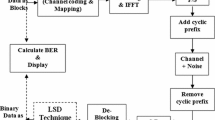Abstract
Recently, a multiple symbol differential (MSD) sphere decoding (SD) algorithm for unitary space-time modulation over quasi-static channel has been proved to achieve the performance of maximum-likelihood (ML) detection with relatively low complexity. However, an error floor occurs if the algorithm is applied over rapid-fading channels. Based on the assumption of continuous fading, a multiple symbol differential automatic sphere decoding (MSDASD) algorithm is developed by incorporating a recursive form of an ML metric into automatic SD (ASD) algorithm. Furthermore, two algorithms, termed as MSD approximate ASD (MSDAASD) and MSD pruning ASD (MSDPASD), are proposed to reduce computational complexity and the number of comparisons, respectively. Compared with the existing typical algorithms, i.e., multiple symbol differential feedback detection (MS-DFD) and noncoherent sequence detection (NSD), the performance of the proposed algorithms is much superior to that of MS-DFD and a little inferior to that of NSD, while the complexity is lower than that of MS-DFD in most cases and significantly lower than that of NSD.
Similar content being viewed by others
References
Hochwald B M, Sweldens W. Differential unitary space-time modulation. IEEE Trans Commun, 2000, 48(12): 2041–2052
Hughes B L. Differential space-time modulation. IEEE Trans Inf Theory, 2000, 46(11): 2567–2578
Bhukania B, Schniter P. Multiple-symbol detection of differential unitary space-time modulation in fast-fading channels with known correlation. In: Proc. CISS-02. NJ, USA, 2002
Chiavaccini E, Vitertta G M. Further results on differential space-time modulation. IEEE Trans Commun, 2003, 51(7): 1093–1101
Pauli V, Lampe L. Multiple-symbol differential sphere decoding for unitary space-time modulation. In: Proc. IEEE GLOBECOM-05. MO, USA, 2005. 1630–1635
Ling C, Li K H, Kot A C. On decision-feedback detection of differential space-time modulation in continuous fading. IEEE Trans Commun, 2004, 52(10): 1613–1617
Ling C, Li K H, Kot A C. Noncoherent sequence detection of differential space-time modulation. IEEE Trans Inf Theory, 2003, 49(10): 2727–2734
Su K. Efficient Maximum Likelihood Detection for Communication over MIMO Channels. Technical Report, University of Cambridge. 2005
Jakes W C. Microwave Mobile Communications. Chap. 2 Piscataway, NJ: IEEE Press, 1993
Zhang Y T, Fang K T. An Introduction to Multivariate Statistical Analysis (in Chinese). Beijing: Science Press, 1999. 94
Damen M O, Gamal H El, Caire G. On maximum-likelihood detection and the search for the closest lattice point. IEEE Trans Inf Theory, 2003, 49(10): 2389–2402
Li Y, Wang X, Wei J B. Multiple symbol differential approximate maximum-likelihood detection for unitary space-time modulation in continuous fading. In: Proc. IEEE International Conference on communication systems (ICCS). Singapore, 2006
Li Y, Wei J B. Pruning automatic sphere decoding algorithm and performance analysis (in Chinese). J Commun, 2007, 28(5): 49–54
Key S M, translated by Luo P F, et al. Fundamentals of Statistical Signal Processing: Detection Theory and Estimation Theory. Beijing: Publishing House of Electronics Industry, 2003. 479–480
Divsalar D, Simon M K. Multiple-symbol differential detection of MPSK. IEEE Trans Commun, 1990, 38(5): 300–308
Biglieri E, Caire G, Tarcco G, et al. Simple method for evaluating error probabilities. Electron Lett, 1996, 32(2): 191–192
Ho P, Fung D. Error performance of multiple-symbol differential detection of PSK signals transmitted over correlated Rayleigh fading channels. IEEE Trans Commun, 1992, 40(10): 1566–1569
Pauli V, Lampe L. Tree-search multiple-symbol differential decoding for unitary space-time modulation. IEEE Trans Commun, 2007, 55(8): 1567–1576
Alamouti S M. A simple transmit diversity technique for wireless communications. IEEE J Select Areas Commun, 1998, 16(8): 1451–1458
Vielmon A, Li Y, Barry J R. Performance of Alamouti transmit diversity over time-varying Rayleigh-fading channels. IEEE Trans Wireless Commun, 2004, 3(9): 1369–1373
Author information
Authors and Affiliations
Corresponding author
Additional information
Supported by the National Basic Research Program of China (973 Program) (Grant No. 2009CB320403), and the National Defense Pre-research Project of the 11th Five-Year-Plan of China (Grant No. 1060741001020102)
Rights and permissions
About this article
Cite this article
Li, Y., Wei, J., Wang, X. et al. Multiple symbol differential detection based on sphere decoding for unitary space-time modulation. Sci. China Ser. F-Inf. Sci. 52, 126–137 (2009). https://doi.org/10.1007/s11432-009-0011-2
Received:
Accepted:
Published:
Issue Date:
DOI: https://doi.org/10.1007/s11432-009-0011-2




